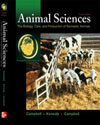
The Physiology of Growth and Senescence |  |
Chapter Summary| In livestock production growth is often defined as the normal increase in weight and body size over a period of time. This is not an accurate definition, however. True growth from a chemical standpoint is an increase in the amount of body protein and mineral matter. Deposition of fat and accumulation of body water are not true means of growth.
The cell is the basic unit of growth. In growth, cells increase in numbers (hyperplasia) and size (hypertrophy). Early embryonic growth is due to an increase in cell numbers, whereas most growth near birth or shortly thereafter can be due to increases in cell size and number. Cell division ceases in some organs much before it does in others.
The postnatal growth curve of all animals is sigmoid (S-shaped). The growth rate of animals decreases shortly after puberty. Many factors are known to affect growth. These include (1) the genetic constitution of the individual, (2) nutrients and environmental conditions encountered during its lifetime, and (3) hormones secreted by the individual's endocrine glands. The life span in multicellular animals is generally related to their age at maturity. A species that reaches maturity more quickly has a shorter life span than one that matures at an older age. As the animal grows older it loses some of its ability to cope with the environment. Although there is not complete agreement on the causes of aging or senescence, most authorities agree that cells either die or lose their ability to function properly. Both processes may be important. In any event, death occurs when one or more vital organs cease to perform their required functions.
Humans and the animals that serve them are by nature predestined, after growth and maturation, to decline and finally die. Their structure and functions are more complex than those of any other living creature. Life is like the flame of a candle whose form is constant while each particle changes every moment. Death takes small bites during the aging process and eventually destroys enough cells that the body tissues fail to function as an integrated entity, resulting in death of the entire organism.
|
|
|